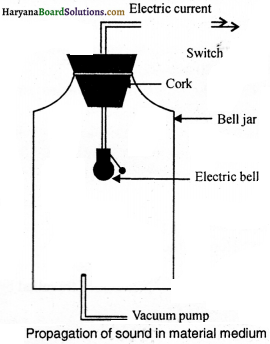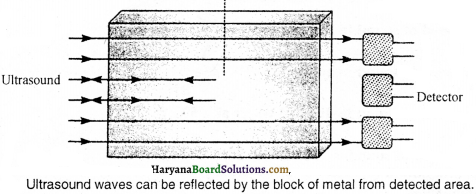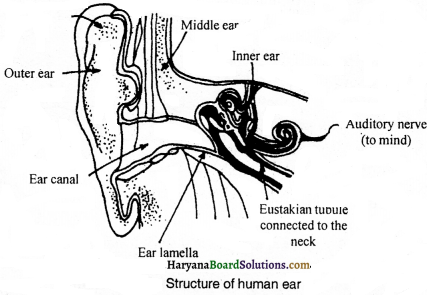Haryana State Board HBSE 9th Class Science Solutions Chapter 12 Sound Textbook Exercise Questions and Answers.
Haryana Board 9th Class Science Solutions Chapter 12 Sound
HBSE 9th Class Science Sound Intext Questions and Answers
Questions from Sub-section 12.2
Question 1.
How does the sound produced by a vibrating object in a medium reach your ear?
Answer:
The sound produced by a vibrating objcct reaches our ear through medium.
Questions from Sub-section 12.2.1
Question 1.
Explain how sound is produced by your school bell.
Answer:
The school bell produces sound through vibration, because when the hammer strikes the bell, it produces vibration in bell.
![]()
Question 2.
Why are sound waves called mechanical waves?
Answer:
The sound waves are produced by the motion of the particles of the medium, and mechanical work is possible by them, so sound waves are called mechanical waves.
Question 3.
Suppose you and your friend are on the moon. Will you be able to hear any sound produced by your friend?
Answer:
No, because sound needs a medium to propagate There is no medium on moon and hence it is not possible to hear any sound on Che moon.
Questions from Sub-section 12.2.3
Question 1.
Which wave property determines
(a) loudness
(b) patch?
Answer:
Pitch.
Question 2.
Guess which sound has a higher pitch : guitar or car horn?
Answer:
Car horn.
Questions from Sub-section 12.2.3
Question 1.
What arc wavelength, frequency, time period and amplitude of a sound wave?
Answer:
(i) Wavelength: The distance between two consecutive compresssions or two consecutive
rarefactions is called wavelength. It is denoted by a Greek alphabet, (lambda)
(ii) Frequency: The number of complete oscillations per unit second is called frequency.
(iii) TIme Period: The time taken by the wave for one complete oscillation is called time period.
(iv) AmplItude: The magnitude of maximum disturbance in the medium on either side of the mean value is called amplitude.
![]()
Question 2.
How are the wavelength and frequency of a sound wave related to its speed?
Answer:
υ = λv
or
Velocity wavelength × frequency.
Question 3.
Calculate the wavelength ora sound wave whose frequency is 220 Hz and speed Is 440 m/s in a given medium.
Solution:
Frequency of wave (υ) = 220 Hz
Velocity of wave (v) = 440 m/s
We know that, = λ × 220
λ = \(\frac {220}{440}\) = 2m
Question 4.
A person is listening to a tone of 500 Hz sitting at a distance of 450 m from the source of the sound. What is the time interval between successive compressions from the source?
Solution:
Frequency of wave (υ) = 500 Hz
Time (T) =?
We know that,
v = \(\frac {1}{T}\)
Or
T = \(\frac {1}{v}\)
T = \(\frac {1}{500}\) = 0.002 sec
Questions from Sith-section 12.2.3
Question 1.
Distinguish between loudness and intensity of sound.
Answer:
The loudness of sound: Loudness is a measure of the response of the ear to the sound. It depends upon low and high vibrations.
The intensity of sound: The amount of sound energy passing each second through unit area is called the intensity of sound.
Questions from Sub-section 12.2.4
Question 1.
In which of three media, air, water or iron, does sound travel the fastest at a particular temperature?
Answer:
The sound travels the fastest in iron. the speed of sound at 25°C in air is 346 m/s, in water 1531 m/s and in iron 5950 m/s.
![]()
Questions from Sub-section, 12.3.
Question 1.
An echo returned in 3s. What is the distance of the reflecting surface from the source, given that the speed of sound is 342 ms-1?
Solution:
Speed nf sound(v) = 342 ms-1
lime taken by echo (t) = 3s
Distance covered by sound = velocity × time = 342 × 3 m = 1026 m
Thus. the distance of the reflecting surface from the source
\(\frac {1026}{2}\) m = 513 m
Questions from Sub-section 12.3.3
Question 1.
are the ceilings nl concert halls curved?
Answer:
The ceilings of concert halls arc curved so that sound after reflection reaches all corners of the hail.
Questions from Sub-section 12.4
Question 1.
What is the audible range of the average human ear?
Answer:
20 Hz to 20.000 Hz.
Question 2.
What is the range of frequencies associated with
(a) Infrasound?
(h) Ultrasound?
Answer:
(a) The range of infrasound is less than 20 Hz.
(b) The range of ultrasound is more than 20 kHz
Questions from Sub-section 12.5
Question 1.
A submarine emits a sonar pulse, which returns from an underwater cliff I.02s. If the speed of sound in salt water is 1531 mIs, how far awa is the cliff?
Solution:
Here, Time between transmission and detection (t) 1.02 s
Speed of sound in seawater (v) = 1531 m/s
Distance traveled by the ultrasound = 2 x distance of cliff from submarine = 2d
Where. d = distance of cliff from submarine
Total distance (2d) = speed x time = 153 1 m/s x 1.02 s = 1561.62rn
d = \(\frac {1561.62}{2}\) = 780.81m.
![]()
HBSE 9th Class Science Sound Textbook Questions and Answers
Question 1.
What is sound and how is it produced?
Answer:
Sound:
It is a form of energy that produces a sensation of hearing. Sound is produced by any vibrating material body. For example. the sound of the human voice is produced due to vibrations in the vocal cords. The strings of trumpets and shehnais vibrate when they are played. The vibration is also produced when the bell is rung. The vibration in bell can be felt by touching it. In this way sound is produced.
Question 2.
Describe with the help of a diagram, how compressions and rarefactions are produced in air near a source of the sound.
Answer:
When a vibrating object moves forward, it pushes and compresses the air in front of it creating a region of high pressure which is called compression (C). This compression starts to move away from the vibrating object. When the vibrating object moves backward, it creates a region of low pressure called rarefaction (R). Thus, due to the vibration of an object, a series of compressions and rarefactions is created in the air. These make the sound wave that propagates through the medium.

Question 3.
Cite an experiment to show that sound needs a material medium for its propagation.
Answer:
Sound is a mechanical wave. It requires a material medium for propagation. ¡t can
be proved by the following experiment:
Experiment:
Take an electric bell and an airtight glass bell jar. The electric bell is suspended inside the airtight bell jar. Connect the bell jar to a vacuum pump. Switch on the bell. The sound of bell is heard. Now pump out the air of bell jar by vacuum pump gradually. The sound becomes fainter. When there is full vacuum in bell jar, the sound of bell will not be heard. Thus, the experiment proves that sound cannot travel in vacuum. Sound need a material medium to travel. The air was the medium in bell jar so the sound of the electric bell was being heard.

Question 4.
Why is a sound wave called a longitudinal wave?
Answer:
In sound waves, the individual particles of the medium move in a direction parallel to the direction of propagation of the disturbance. The particles do not move from one place to another but they oscillate back and forth about their position of rest. Hence, sound waves are longitudinal waves.
![]()
Question 5.
Which characteristic of the sound helps you to identify your friend by his voice while sitting with others in a dark room?
Answer:
Pitch of sound. How the brain interprets the frequency of an emitted sound is called pitch. Pitch helps us to identify the sound.
Question 6.
Flash and thunder are produced simultaneously. But thunder ¡s heard a few seconds after the flash is seen, why?
Answer:
At room temperature. the speed of sound is 344 metres per second and the velocity of light is 300000 km per second. Flash and thunder are produced simultaneously but due to the difference in the speed of both, flash is seen first and thunder is heard after it.
Question 7.
A person has a hearing range from 20 Hz to 20 kHz. What are the typical wavelengths of sound waves in air corresponding to these two frequencies? Take the speed of sound in air as 344 ms-1.
Solution:
The velocity of sound in air (y) = 344 ms-1
First frequency of person (v1) = 20 Hz
Second frequency of person (v2) = 20 kHz = 20,000 Hz
First wavelength (λ1) = \(\frac{v}{v_1}=\frac{344}{20}\) = 17.2 m
Second wavelength (λ2) = \(\frac{v}{v_2}=\frac{344}{20,000}\) = 0.0172 m
Question 8.
Two children are at opposite ends of an aluminum rod. One strikes the end of the rod with a stone. Find the ratio of times taken by the sound wave in air and in aluminum to reach the second child.
Solution:
Suppose the length of rod = 1m
Speed of sound in air (v1) = 346 m/s
Time taken in Air = ![]() = \(\frac {1m}{346m}\)s 1/346s
= \(\frac {1m}{346m}\)s 1/346s
The speed of sound in aluminium (v2) = 6420 m/s
Time taken in Aluminium = ![]() = \(\frac {1m}{6420m}\) = I /6420s
= \(\frac {1m}{6420m}\) = I /6420s
Ratio of both = \(\frac{1}{346}: \frac{1}{6420}\) = 18.55:1
![]()
Question 9.
The frequency of a source of sound is loo Hz. How many times does it vibrate in a minute?
Solution:
Frequency of sound (v) = 100 Hz
Number of vibrations in 1 second = 100
Number of vibrations in 60 seconds = 100 x 60 = 6000
Question 10.
Does sound follow the same laws of reflection as light does? Explain.
Answer:
Yes, sound follows the same laws of reflection as light does. Sound is reflected from the surface of
Laws:
(1) The angle of incidence is equal to the angle of reflection.
(2) Incident wave, reflected wave and the normal lie in the same plane. An obstacle of larger size which may be polished or rough is needed for the reflection of sound waves.
Question 11.
When a sound is reflected from a distant object, an echo is produced. Let the distance between the reflecting surface and the source of sound production remains the same. Do you hear an echo sound on a hotter day?
Answer:
Yes, because the speed of sound is more on a hotter day than on a colder day.
Question 12.
Give two practical applications of reflection of sound waves.
Answer:
(1) During night, the bats feel their way by the reflection of sound.
(2) Ultrasound is used to break small ‘stones’ formed in the kidneys into fine grains.
Question 13.
A stone is dropped from the top of a tower 500 m high into a pond of water at the base of the tower. When is the splash heard at the top? Given, g = 10 m/s-2 and speed of sound = 340 ms-1.
Solution:
Here, u 0, s 500 m, g 10 rns2
Buts = ut + gt2 = 0 + \(\frac {1}{2}\) x 1o × t2 ⇒ 5t2 = 500 or = 10s
Distance of the top of the tower from surface faster = 500 m
Speed of sound = 340 ms-1
![]()
\(\frac {500}{340}\) = 1.47s
The time taken by the splash to reach at the top = 10 + 1 .47 = 11.47 s
![]()
![]()
Question 14.
A sound wave travels at a speed of 339 ms-1. If its wavelength is 1.5 cm, what is the frequency of the wave? Will it be audible?
Solution:
Here, the Speed of the sound wave = 339 ms-1
Wavelength = 1.5 cm = \(\frac {15}{10}\) = \(\frac {15}{1000}\) m
Frequency Wavelength = img = \(\frac {339}{15}\) x 1000 = 22600 Hz
This sound is not audible because a person cannot hear a sound more than 20,000 Hz.
Question 15.
What is reverberation? How can it be reduced?
Answer:
Reverberation:
The repeated reflection that results in the persistence of sound is called reverberation. Methods of reducing:
To reduce reverberation, the roof and walls of the auditorium are generally covered with sound absorbent materials like compressed fibreboard, rough plaster or draperies. The seat materials are also selected on the basis of their sound-absorbing properties.
Question 16.
What is the loudness of sound? What factors does it depend on ?
Answer:
The measure of the response of the ear to the sound is called the loudness of sound. It is the sensation of hearing. This level of sensation depends upon the loud or faint vibrations of the source. When vibrations are loud, the loudness of sound is more and when vibrations are faint, the loudness of sound is faint. The loudness or softness of the sound is found by the amplitude. The sound of high energy has more loudness.
Question 17.
Explain how bats use ultrasound to catch a prey.
Answer:
The bat searches out prey in dark night by emitting and detecting reflections of ultrasonic waves. The high pitch ultrasonic squeaks of the hat are reflected from the prey and returned to the bat’s ear as shown in fig. The nature of reflections tells that bat where the prey is and it catches it. In this way the bats use ultrasound to catch prey.

Question 18.
How is ultrasound used for cleaning?
Answer:
Objects to be cleaned are placed in a cleansing solution and ultrasonic waves are sent into the solution. Due to the high frequency. the particles of the dust, grease and dirt get detected and drop out. This technique can clean those objects which are difficult to clean due to their large size.
![]()
Question 19.
Explain the working and application of a sonar.
Answer:
Procedure:
SONAR-Sound Navigation And Ranging is such a device in which ultrasonic waves are used to measure the distance, direction and speed of underwater objects. Sonar consists of a transmitter and a detector and is installed in a boat or a ship as shown in fig. The transmitter produces and transmits ultrasonic waves and travel through water and after striking the object on the seaboat, get reflected back and are sensed by the detector. The distance of the object that reflected the sound wave can he calculated by knowing the speed of sound in water and the time interval between transmission and reception of the ultrasound.

Applications: Following are its applications:
(1) To determine the depth of the sea and oil wells.
(2) To find the distance of groups of fish.
(3) To locate the enemy submarine or torpedo.
(4) To cate underwater hill valleys. icebergs and sunken slp.
Question 20.
A sonar device on a submarine sends out a signal and receives an echo 5 s later. Calculate the speed of sound in water, if the distance of the object from the submarine is 3625 m.
Solution:
Distance of the object from the submarine (d) = 3625 m
The echo covers the double distance.
2d = 2 x 3625 = 7250 m
Time (t) = 5 s
Speed of sound in water = \(\frac {2d}{t}\) = imh = \(\frac {7250}{5}\) = 1450 m/s
Thus, speed of sound in water 1450 m/s
![]()
Question 21.
Explain how defects in a metal block can be detected using ultrasound.
Answer:
Ultrasound can be used to detect cracks and flaws in metal blocks. The cracks or holes inside the metal blocks, which are invisible from the outside reduce the strength of the structure of the building or bridge.

Ultrasonic waves are allowed to pass through the metal block and detectors are used to detect the transmitted waves. If there is even a small defect, the ultrasound gets reflected back indicating the presence of the flaw or defect. Ordinary sound of longer wavelengths cannot be used for such purpose as it will bend around the corners of the defective location and enter the detector and instead of detecting the flaw, they create a state of confusion.
Question 22.
E%plaìn how the human ear works.
Answer:
The outer ear of human being collects the sound from surroundings and passed through the auditory canal, and the pressure on the outside of the membrane increases. The pressure from inside is less. Due to the difference in pressure, the eardrum starts vibrating. The vibrations are amplified several times by three bones (the hammer, anvil and stirrup) in middle ear. In the inner ear, the pressure variations are turned into electric signals by the cochlea. These electrical signals are sent to the brain via the auditory nerve, and the brain interprets them as sound.
